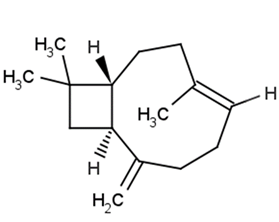
β-Caryophyllene
CAS No. 87-44-5
β-Caryophyllene( Caryophyllene | AI3-36121 | CCRIS 8094 | E-Caryophyllene )
Catalog No. M19206 CAS No. 87-44-5
β-Caryophyllene is a CB2 receptor agonist.
Purity : >98% (HPLC)
 COA
COA
 Datasheet
Datasheet
 HNMR
HNMR
 HPLC
HPLC
 MSDS
MSDS
 Handing Instructions
Handing Instructions
| Size | Price / USD | Stock | Quantity |
| 500MG | 37 | In Stock |


|
| 1G | Get Quote | In Stock |


|
Biological Information
-
Product Nameβ-Caryophyllene
-
NoteResearch use only, not for human use.
-
Brief Descriptionβ-Caryophyllene is a CB2 receptor agonist.
-
DescriptionCaryophyllene is a natural bicyclic sesquiterpene that is a constituent of many essential oils, especially clove oil, the oil from the stems and flowers of Syzygium aromaticum (cloves), the essential oil of Cannabis sativa, rosemary, and hops. It is usually found as a mixture with isocaryophyllene (the cis double bond isomer) and α-humulene (obsolete name: α-caryophyllene), a ring-opened isomer. Caryophyllene is notable for having a cyclobutane ring, as well as a trans-double bond in a 9-membered ring, both rarities in nature.(In Vitro):Among the tested cancer cells, β-Caryophyllene demonstrates selective anti-proliferative effect against three cancer cell lines, namely HCT 116 (colon cancer, IC50=19 μM), PANC-1 (pancreatic cancer, IC50=27 μM), and HT29 (colon cancer, IC50=63 μM) cells, whereas β-Caryophyllene exhibits either moderate or poor cytotoxic effects against ME-180, PC3, K562 and MCF-7. Results show that β-Caryophyllene possesses higher selectivity towards the colorectal cancer cells (HCT 116), with selectivity index (SI)=27.9, followed by PANC-1 and HT 29 cells with SI=19.6 and 8, respectively. The apoptotic index estimated for β-Caryophyllene treatment on HCT 116 cells after 24 h treatment is 64±0.04. β-Caryophyllene at 10 μM concentration, causes significant nuclei condensation after 6 h of treatment. β-caryophyllene exhibits a dose and time-dependent inhibitory effect on the motility of HCT 116 cells. (In Vivo):Treatment with β-Caryophyllene at different doses does not show any effects on swimming speed during the test. Oral treatment with β-Caryophyllene ameliorates the rise in β-amyloid deposition in the transgenic mice in a roughly dose-dependent manner, and the two higher doses exhibit almost equal effects in modifying the β-amyloid burden. The number of activated astroglial cells is higher in vehicle-treated mouse brains than in β-Caryophyllene-treated mouse brains with different doses. β-Caryophyllene is effective at reducing the enhancement of the COX-2 protein level found in vehicle-treated APP/PS1 mice. Animals treated with β-Caryophyllene display higher values of object recognition index than their vehicle-treated counterparts [t(14)=4.204, P<0.05]. The total time spent in object exploration during the test trial is not significantly different between β-Caryophyllene-treated and vehicle-treated animals (t(14)=0.5874, P>0.05). Treatment with β-Caryophyllene does not significantly alter these seizure-induced neurochemical changes.
-
In Vitro——
-
In Vivo——
-
SynonymsCaryophyllene | AI3-36121 | CCRIS 8094 | E-Caryophyllene
-
PathwayOthers
-
TargetOther Targets
-
RecptorCB2
-
Research Area——
-
Indication——
Chemical Information
-
CAS Number87-44-5
-
Formula Weight204.35
-
Molecular FormulaC15H24
-
Purity>98% (HPLC)
-
SolubilityEthanol : ≥ 176.67 mg/mL 864.55 mM DMSO : < 1 mg/mL; H2O : < 0.1 mg/mL
-
SMILESCC1=CCCC(=C)C2CC(C2CC1)(C)C
-
Chemical Name(1R,9S,E)-4,11,11-trimethyl-8-methylenebicyclo[7.2.0]undec-4-ene
Shipping & Storage Information
-
Storage(-20℃)
-
ShippingWith Ice Pack
-
Stability≥ 2 years
Reference
1. Cheng Y, etal. β-Caryophyllene ameliorates the Alzheimer-like phenotype in APP/PS1 Mice through CB2 receptor activation and the PPARγ pathway. Pharmacology. 2014;94(1-2):1-12.
molnova catalog



related products
-
TG-2-IN-1
TG-2-IN-1 is a potent transglutaminase-2 (TGM-2) inhibitor.TG-2-IN-1 is used in the study of cancer, neurological disorders, and immune system disorders.
-
Mepacrine
Mepacrine (Erion) is an acridine derivative formerly widely used as an antimalarial. It is used in cell biological experiments as an inhibitor of phospholipase A2.
-
Daratumumab
Daratumumab is a human monoclonal antibody that targets CD38 a cell surface protein that is overexpressed on multiple myeloma MM) cells.



 Cart
Cart
 sales@molnova.com
sales@molnova.com


